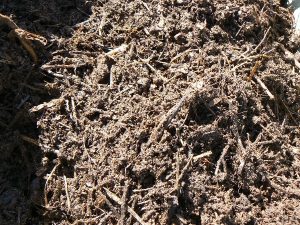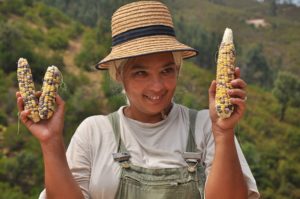Soil is the basis for gardening. When the soil in your vegetable garden is healthy you will have good results in your garden.

What is healthy soil like? Healthy soil for your vegetables contains enough nutrients for your plants to grow. The soil also drains and retains water well enough for your plants. It is not compacted and contains little pockets of air. It feels fluffy and slightly moist and has little lumps sticking together.
To create this soil, for an organic gardener it means that you have enough organic material in your soil. Small microorganisms that live in the soil will digest this organic material into nutrients that can be eaten by the plants. This end product what is edible for plants is called humus. Humus is the pantry for the plants.
My favourite way of gardening is to feed the microorganisms in the soil with organic material, so they do the gardening job for me. This way I do not need to till hardly ever and I can reduce the amount of water I have to give to my plants. Because apart from being food for the microorganisms the organic material also makes the soil be able to retain more water.
The organic matter I feed to the microorganisms in the soil is compost, composted manure, green manure clippings, weeds that don’t contain seeds or anything else I can find that is suitable.
In the end the healthy soil is a mixture of soil that was at the spot where I garden, composting organic matter and humus. That soil works very well.
When you go to a forest and check under the deciduous trees you will find the basis of healthy soil. That black loose soil works like a sponge, mix it with some sand or clay and you get the most wonderful soil for planting. It will keep it’s moisture easily and be nice and soft. It smells like the earth under a tree.
Once, in Holland, 15 years ago, me and my husband moved to another house in town. The backyard was a dead place. Nothing was growing there.
We went to the forest in our car and packed our car with bags of forest soil. We spread it in our new backyard. Then we added the compost I had made in the previous house we were living in. And we planted peas around the yard so they would grow on the fence.
Halve a year later there was so much growing in the backyard that we could not get into it ourselves any more. We had to cut back a jungle to enter.
Actually it is worth making a fact finding mission into the nearest forest or park. You do need to go to a forest with deciduous trees. Trees with needles produce a different type of humus that is not as suitable for growing vegetables in.
So, go look under these trees in a park or forest. Walk under the trees and feel where the soil is kind of springy. Shift some fallen leaves aside and take some soil from under the leaves in your hand. Smell it and feel the texture. Feel the looseness of the texture. Study it a bit, what do you see. Is it like sand? Has it got some lumps that stick together?
Go a bit to the edge from the tree canopy, where the black soil from under the tree mixes with other soil. Pick some up again. How does it smell, look and feel. What is growing there? What color green do the leaves from the plants that are growing there have? Is it loose sand? Has it got lumps that stick together? The soil you are looking for has this smell, it also has the small lumps that stick together.
Don’t stop there. Wherever you go, pick up soil. Feel it, smell it. Maybe not where it is very dirty with dog poop or so. You know what I mean. You can still take a look at it, but maybe not smell or feel it. Look at what is growing where you picked up the soil. Is it poor, is it lush? Is it crumbly or compacted? Would you want to have that soil in your garden?
This way you will develop an eye for good soil. The places where things grow lush are mostly the places with good soil. Do you find the same plants where you want to start you vegetable garden?
Now you know what kind of soil you are looking for. Go to your chosen plot and take a good look at the soil. Feel it, smell it. Look what is growing there.
When I start a garden somewhere that’s what I always do. If I have to choose which allotment to rent or where on our land I should start my vegetable garden, that is what I do.
Since I know that it is very unlikely that I will find the ideal soil, I kind of look for the potential that the soil has. Does it come close to what it should be. I make sure it at least has the lumpy structure. How much effort will I need to put in to make my garden work? That is my main question. The least as possible is my answer.
Don’t worry if you do not have an ideal place. Just pick out the best one you can find. Many places on this earth are not blessed with the best soils. In Holland where I come from we have a lot of fertile river soils. Clay or sand. These are special soils. Having those soils is more an exception then a rule. River delta or river bed soil is usually very fertile. That also means that you will find the best land to garden near a river or in an old river bed.
What also can help to know more about your vegetable plot is to dive into history. In the town where I used to live in Holland, in Wageningen, there are a lot of old photographs of the area. I checked those photographs to find out more about our small yard and about our vegetable plot.
In the area where our previous house is, there was a grain field. In the area where our previous vegetable plot was, was a tobacco field. So I knew that both areas where already used for agriculture, so the land would be good to grow vegetables (or just any plants).
Sometimes elder neighbours will still remember what the place was like. Or maybe you can find some info in the local library.
After having read this blog evaluate the place where you want to make your vegetable garden. And make a choice.
In the next blog we will look deeper into the soil matters. And see what more you need to find out about your soil to make your vegetable garden work well.
See you next time!
